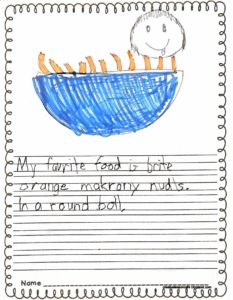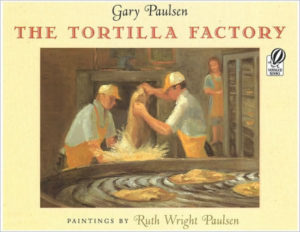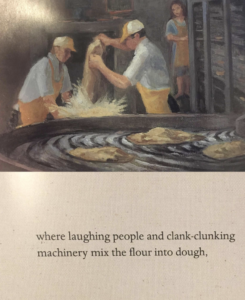I have actually had this book for years. I frequently use it in my Writers’ Workshop session and Expository Text session. Every time I share it in a session, teachers are drawn to the book and I am enamored by it all over again. So I thought it was time I shared it on the blog!
Why I Finished It:
The language is addicting. It’s simple and short, but in true Gary Paulsen form, it captivates you, creating a thousand pictures with one fascinating sentence. The text takes you from the farming of corn through the creation of a tortilla to eat for strength to farm more corn. Each page of poetic text has rich, warm paintings by Ruth Wright Paulsen. The text and paintings together create a calm that is hard to describe.
Who I Would Give It To:
This is a great mentor text for grades K-8! It has that kind of range since you can focus on different parts for different reasons. I think this is a great fall read aloud, a nontraditional Thanksgiving-type read.
Integration Ideas:
One type of text structure (usually taught with a fiction unit) is circular stories. Probably some of the most popular are the If You Give series. Another we love is Charlie Cook’s Favorite Book. The idea of a circular story is that the story will end in the same place it begins. Little kids LOVE THIS! Trust me, it is HIL-AR-IOUS! Have a talk with students, after reading The Tortilla Factory, about how we ended where we began. From this point, connect for students how this is a cycle. Create the visual on the board for the students. Then ask students what other cycles they know about. If they are slow to respond, branch out their thinking with ideas like (the water cycle, the life cycle of a butterfly, the life cycle of a plant, etc.)
Have students read other circular texts and create their own organizer that provides a visual for the text.
 Descriptive Language and Word Choice
Descriptive Language and Word Choice
For the youngest of students, they can concentrate on Paulsen’s description of colors and shapes. For example; black earth, golden corn, round stomach, etc. Turn this into a writing assignment for the students. Have them brainstorm some of their favorite foods. Choose one of the foods and write a sentence using color and shape words. Don’t forget the beautiful illustration. If you’re daring enough, let them paint it as Ruth Wright Paulsen did!
For older students, have them pay attention and analyze the sensory language. One example is this page:
To use this as a mentor text, begin by having students explain what they notice. After a while, ask what sounds they hear, what sights they see, what odors they smell, etc. Don’t stop students short at identifying the imagery, have them explain the author’s purpose. Have a discussion about why the author used imagery here and how it helps create a message or scene. What is the effect of the imagery? Next, have students go into their own writing and choose a place where they can describe a smell, or a sound, or a taste. I like to let the students work in groups with a thesaurus and lots of mentor texts that have strong description. As a group, they help each member write a powerful, descriptive sentence filled with imagery. Of course, we share!
Expository Text – Sequence
This is circular, yes, but it is also a sequence. This text is walking students through a step-by-step process in a way that is not boring (like recipes). Have students choose one of the cycles discussed in the beginning and conduct informal research. Have them write out about 4-7 steps of the cycle. Then put each cycle on a different page/paragraph (depending on age), and practice expanding the idea. Add imagery like we already practiced, describe the colors and shapes, provide extra details or facts. Explode the moment!
Art
I will not even pretend that I know about art! However, the illustrations in this text are begging the reader to try painting. I am daring enough to let the students paint pictures to go with their expository text above. If it were me, I would include the art teacher! What a great connection! I would work together to create art requirements and classroom requirements for each drawing.
How do you use this mentor text?









Leave a Reply